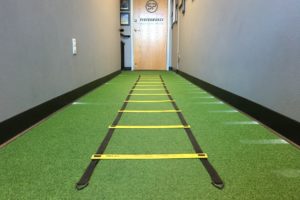
1. Determine when/why it happened
Most running injuries don’t show up during your first run of the season. They start as little nagging sensations, or tightness in certain muscle groups. Over time as you continue to increase your training mileage, that little spot of tightness becomes painful. Then that pain becomes something that limits your running mileage and running enjoyment.

The best way to assess the cause of your running injury is to be tracking your daily/weekly mileage and logging any symptoms that crop up that week. Often, runners will find that they were feeling fine up to a certain point, but then exceeded their ability to recover and adapt to their training when their mileage increased beyond a certain point.
The only way to know is to track! Make an Excel spreadsheet. Use your FitBit or activity tracker when you’re running. Write down when you’re feeling tight, or feeling new pains! This information will also help your physical therapist if you get to the point where you cannot self manage your symptoms.
The only way to know is to track!
2. Trial a change in technique or shoe wear to see if you can temporarily improve your symptoms
Oftentimes, minor changes in technique can temporarily improve your symptoms and help to offload painful tissues. Many people find success with increasing their cadence (steps per minute) as this decreases the force going through the lower extremities during each step. For other ways to improve your running efficiency and technique, check out our latest running blog (CLICK HERE).
Shoe wear can also have an impact on your pain. If you just recently got a new pair of running shoes and started to develop pain after a week of running, maybe your body wasn’t fully adjusted to the new shoes. Use your old shoes for a few runs and GRADUALLY introduce your new shoes into your training. Find shoes that are comfortable for you and no matter the shoe, take your adjustment period seriously.

Use your old shoes for a few runs and GRADUALLY introduce your new shoes into your training.
3. Establish your run tolerance
The next step is to determine if there is a distance that you can tolerate without a lasting flare-up in symptoms. A lasting flare up would mean an increase in your pain that doesn’t resolve within 24 hours of your run.

For example, if you can run 5 miles with pain resolving the next day but 7 miles seems to flare you up for two days, then run only 5 miles for your next training run, and bump to 6 miles for your next run. THEN you could try 7 miles again to see if you’re now able to handle 7 miles.
4. Monitor your pain in response to training
Keep a log of when your pain flares up and when it doesn’t. You might also consider logging the intensity of your sessions on a 10 point scale (see below) to see if intensity is what really flares you up, or if it’s weekly mileage that affects you more. An even better option would be to monitor your fatigue or stress levels and sleep duration to see if your pain is worse when you’re feeling tired or overwhelmed by the rest of your life (this is more common than you would think!)

Keep a log of when your pain flares up and when it doesn’t.
5. Build your distance before your pace
Continually increase your mileage within the limits of your ability to feel recovered by your next run (GENERALLY no more than 10% per week) and once you hit your desired distance, start running that distance faster.
As always, I hope this helps! If you have any questions or would like to read about certain topics, send us an email at TeamSP@SportsPerformancePT.com.
-Dr. Marissa Rescott, PT, DPT, CF-L1

STAY CONNECTED:
Instagram: CLICK HERE
Facebook: CLICK HERE
YouTube: CLICK HERE
Podcast: CLICK HERE
Online Store: CLICK HERE
TUNE IN TO OUR PODCAST








